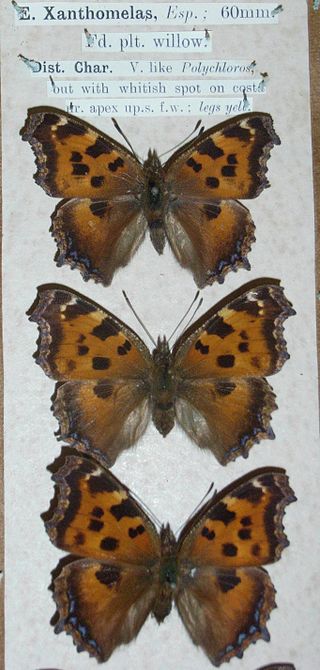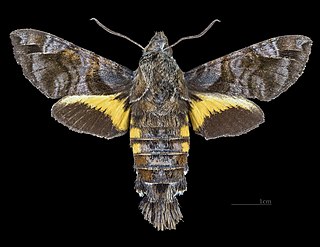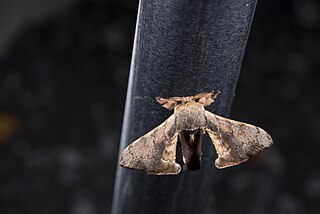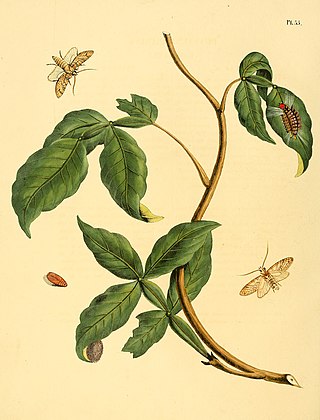
Anthene emolus, the ciliate blue, is a small butterfly found in India and southeast Asia that belongs to the lycaenids or blues family. The species was first described by Jean-Baptiste Godart in 1823.

Nephele hespera, the crepuscular hawkmoth, is a sphingid moth described by Johan Christian Fabricius in 1775.

Horaga onyx, the common onyx, is a species of lycaenid or blue butterfly found in the Indomalayan realm.

Hippotion celerio, the vine hawk-moth or silver-striped hawk-moth, is a moth of the family Sphingidae. It was described by Carl Linnaeus in his 1758 10th edition of Systema Naturae.

Nymphalis xanthomelas, the scarce tortoiseshell, is a species of nymphalid butterfly found in eastern Europe and Asia. This butterfly is also referred as yellow-legged tortoiseshell or large tortoiseshell.

Corcobara is a monotypic moth genus of the family Erebidae first described by Frederic Moore in 1882. Its only species, Corcobara angulipennis, described by the same author in the same year, is found in India, Thailand, Cambodia, Myanmar, Malaysia, Indonesia, New Guinea, Sri Lanka and the Solomons.

Macroglossum insipida, the hermit hummingbird hawkmoth, is a moth of the family Sphingidae. It was described by Arthur Gardiner Butler in 1875.

Thyas coronata is a species of moth of the family Erebidae first described by Johan Christian Fabricius in 1775. It is found from the Indo-Australian tropics of southern China, Taiwan, Japan, Nepal, India, Sri Lanka to Micronesia and the Society Islands.

Eudocima homaena is a moth of the family Erebidae first described by Jacob Hübner in 1816. It is found in the Indian subregion, Sri Lanka, Myanmar, Taiwan, the Nicobars, Peninsular Malaysia, Borneo, the Philippines and on Christmas Island. It is a major pest on orange plants.

Eudocima salaminia, the green fruit-piercing moth, is a moth of the family Erebidae. The species was first described by Pieter Cramer in 1777. It is found from India, and across south-east Asia to the Pacific Islands. In Australia it occurs in the Northern Territory, Queensland and New South Wales. The adult is a fruit piercer.

Pergesa is a monotypic moth genus in the family Sphingidae first described by Francis Walker in 1856. Its only species, Pergesa acteus, the green pergesa hawkmoth, was described by Pieter Cramer in 1779.

Asota plana is a moth in the family Erebidae first described by Francis Walker in 1854. It is found from the Oriental tropics east to New Guinea.

Acosmeryx shervillii, the dull forest hawkmoth, is a moth of the family Sphingidae. The species was first described by Jean Baptiste Boisduval in 1875. It is found from the Indian subregion, Sri Lanka, to Sundaland, the Philippines and Sulawesi. Acosmeryx pseudonaga is sometimes treated as a valid species.

Chadisra bipars is a moth of the family Notodontidae. It was described by Francis Walker in 1862 and is found in the Indomalayan realm.

Ischyja manlia is a species of moth of the family Noctuidae first described by Pieter Cramer in 1776. It is found in the Indian subregion, Sri Lanka, Myanmar, Thailand, China, Okinawa, Sundaland, Sulawesi, Korea, the southern Moluccas, Australia (Queensland) and Palau.

Trilocha varians, the Greenish silk-moth is a moth in the family Bombycidae described by Francis Walker in 1855. It is widespread in the Oriental region from India, Sri Lanka, China, extending to Taiwan, the Philippines, Pakistan, Sulawesi and Java.

Orgyia postica, the cocoa tussock moth or hevea tussock moth, is a species of moth of the subfamily Lymantriinae of the family Erebidae found in the Oriental tropics of India, Sri Lanka, Myanmar, Borneo, Java, New Guinea, and Taiwan. It was described by Francis Walker in 1855.
Lemyra subfascia is a moth of the family Erebidae. It was described by Francis Walker in 1855. It is found in Sri Lanka.

Lophocampa citrina is a moth of the family Erebidae. It was described by Jan Sepp in 1843 as Phalaena citrina. It is found in Mexico, Honduras, Panama, French Guiana, Brazil, Venezuela and the Amazon region.
Drapetodes magnifica is a moth in the family Drepanidae. It was described by Charles Swinhoe in 1902. It is found on Peninsular Malaysia, Sumatra, Java and Borneo.

















